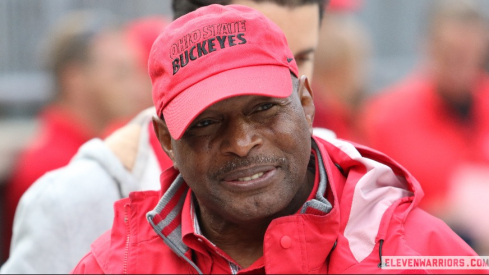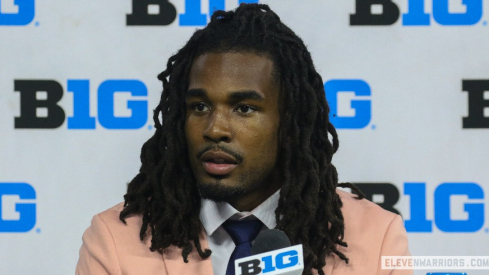
I previously looked at the concepts and run game behind Urban Meyer's Ohio State offense.
Now I want to turn to the passing game.
Throw when theY're on their Heels
As previously noted, OSU is a run-first offense. If a defense plays with its base defense against the Buckeyes, OSU will continue to run the football. OSU looks to pass once a defense begins overplaying the run game.
To put it another way:

It follows that the passing game is designed to defeat teams using aggressive safety support. The passing game cannot only do just that, because the Buckeyes must be prepared to throw in passing situations. But the goal is to run the ball effectively until a defense has to overcommit. Then OSU can take advantage of a numbers advantage downfield.
Throw it where they ain't
The Buckeyes' passing game therefore seeks to exploit safeties and linebackers who are overly focused upon the run game. Much of the playbook attacks a 15-yard box inside the curl to flat zone on each side of the defense.

OSU wants to take advantage of a defense having fewer linebackers and safeties within area because they are playing the run. The Buckeyes then use route combinations that create 'stretches' upon those remaining safeties and linebackers.
Meyer's primary weapon for doing so is his slot or 'H' receiver. Meyer's inside receivers are generally the focus of the passing game. Corey Brown filled this role on third down for OSU in 2012 and led the Buckeyes in catches. Meyer wants to quickly get the ball to his most dynamic receiver in these vacated spaces to earn yards after the catch.
The base of the OSU passing offense then is routes featuring its playmaker at H in the middle of the field area. This comes in the form of option routes, shallow crossing, and triangle stretches. I will address each in turn.
H Option
If the 'H' receiver is Meyer's go-to receiver, then "H" option is his simplest way to get that player the football. As Coach Hoover wrote:
H Option is a play designed to get the ball into the hands of the offense's most dynamic playmaker. First it was Paris Warren at Utah, and then at Florida it was Percy Harvin, after whom the position was commonly referred to as the "Percy Position." It is the football equivalent to the basketball play where everybody spreads the court and gets out of the way to let your best player take his guy 1 on 1.
The H-receiver is going to run right at the inside defender. He wants to attack that defender's inside leverage and try to beat him inside. If he cannot, he will plant and cut outside. If he is bracketed, he will hook and settle down. If he cannot get open on this initial cut, he has the freedom to cut across the middle on a shallow cross. The upshot is that this receiver has the freedom to use his athleticism to make one cut and get open. The mechanics are less important than this straightforward facet.

The backside inside receiver runs an option route at 10 yards. He will also work at the inside defender but then hook or break outside so as not to interfere with the primary option route. The other wide receiver runs go routes, but 'tags' can also be built into the play, such as hitch or out routes if the defense is playing soft coverage. Again, though, the goal here is to give the H receiver freedom to get open.
The Shallow Cross Duo: Follow and Drive
The next prevalent plays for the Buckeyes are shallow crossing routes. OSU's shallow cross plays build off H-option. As with H-option, one inside receiver is going to commence the play by attacking the inside defender's inside shoulder. Rather than running an option route, however, he is going to continue going vertically with a seam route. The goal is to occupy that curl/flat defender. Then, from the opposite side will come the two shallow-curl routes.
Meyer's primary shallow cross play is 'follow.' With follow, the inside receiver runs an immediate shallow route. The next receiver runs the "follow" or dig route that trails behind the shallow cross. He will break the route off inside at 8 yards. With the frontside defender occupied with the threat of H-option, the two shallow crosses should have a 2-on-1 vertical stretch on the inside linebacker. Alternatively, if the defense is in man coverage, the crossing receivers can run away from the man coverage. The QB reads the play shallow to follow route. He will key the first defender over the seam route to the next inside linebacker. It is a straightforward 2-on-1 read that occurs immediately in his vision.

'Drive' is the same basic concept as follow but flips the two crossing routes. With drive, the outside receiver runs the shallow cross route, while the inside receiver runs a 12-yard in. Drive again seeks a hi-lo vertical stretch. Teams will vary the primary read. OSU generally seeks to hit the square-in behind the shallow route. The Buckeyes then put a post route over the top to hit if the safety jumps the in-route.
OSU will also combine a shallow cross concept with an outside two-man route combination, such as 'smash.' This allows the offense to be prepared versus a variety of coverages. For instance, the shallow crosses are good versus man or cover 3 while smash attacks cover 2.
These option and shallow crossing routes form the base of the Buckeye passing game. Next week I will expand to the next group of routes, particularly those OSU runs against cover 4.

